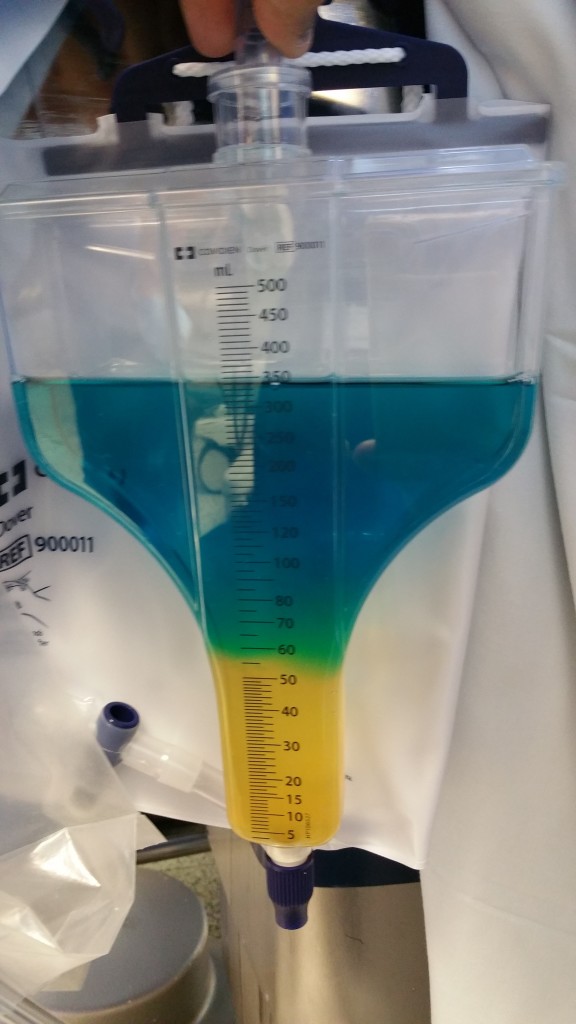Kay Anne Mak, MBChB1, Santhana Kannan, MD, DNB, FRCA2
1Core Trainee; 2Consultant
Dept of Anaesthesia, City Hospital, Birmingham (UK)
Correspondence: Dr S. Kannan, Dept of Anaesthesia, City Hospital, Dudley Road, Birmingham B18 7QE (UK); Phone: 0044 121 5074343; E-mail: kannan.gas@gmail.com
A 78-year-old lady underwent extensive primary de-bulking surgery for ovarian cancer. Intraoperatively, blue-green colored urine was observed in the urinary bag (Figure 1). There was a clear demarcation of the coloured urine sitting on top of the previously passed urine. On this occasion, the blue green discolouration was caused by instillation of methylene blue into the ureter by the surgeon to monitor for ureteral injury. The colour of patient’s urine returned to normal after six hours.
Methylene blue is moderately soluble in water and has a specific gravity of 1.335. Hence it is rare to see the layered discolouration. True blue urine is unusual as blue pigments combine with urochrome, the major contributor to urine's normal yellow hue, to create the green color. The figure shows the three coloured layers - a top layer which is predominantly blue, due to methylene blue solution unmixed with urine, a middle layer of green caused by mixing of methylene blue with urine and a bottom layer of normal unmixed urine. Phenol-containing drugs such as propofol can cause green discolouration of urine. Although a single dose of propofol has been reported to cause green urine, this was considered unlikely in our case as the surgeon had informed us that he was instilling methylene blue.

Figure 1: Urine bag showing three layers of different colored urine
1Core Trainee; 2Consultant
Dept of Anaesthesia, City Hospital, Birmingham (UK)
Correspondence: Dr S. Kannan, Dept of Anaesthesia, City Hospital, Dudley Road, Birmingham B18 7QE (UK); Phone: 0044 121 5074343; E-mail: kannan.gas@gmail.com
A 78-year-old lady underwent extensive primary de-bulking surgery for ovarian cancer. Intraoperatively, blue-green colored urine was observed in the urinary bag (Figure 1). There was a clear demarcation of the coloured urine sitting on top of the previously passed urine. On this occasion, the blue green discolouration was caused by instillation of methylene blue into the ureter by the surgeon to monitor for ureteral injury. The colour of patient’s urine returned to normal after six hours.
Methylene blue is moderately soluble in water and has a specific gravity of 1.335. Hence it is rare to see the layered discolouration. True blue urine is unusual as blue pigments combine with urochrome, the major contributor to urine's normal yellow hue, to create the green color. The figure shows the three coloured layers - a top layer which is predominantly blue, due to methylene blue solution unmixed with urine, a middle layer of green caused by mixing of methylene blue with urine and a bottom layer of normal unmixed urine. Phenol-containing drugs such as propofol can cause green discolouration of urine. Although a single dose of propofol has been reported to cause green urine, this was considered unlikely in our case as the surgeon had informed us that he was instilling methylene blue.

Figure 1: Urine bag showing three layers of different colored urine